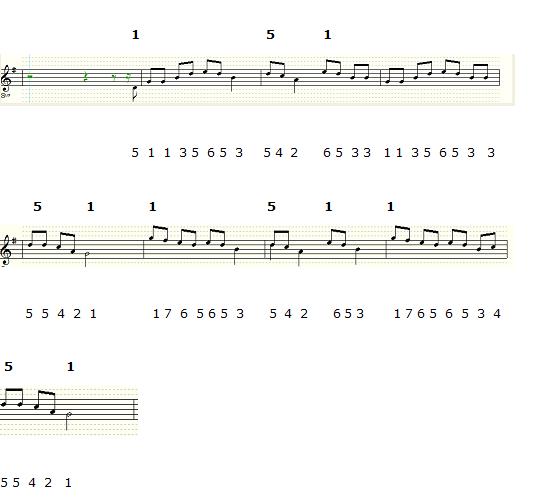Fiddlewidget for String Teachers
| Home | What's a Fiddlewidget? | Suppliers | Fiddlewidget University | Instruments |
Activity 6a-Finding Harmony Parts- Identifying the Lead (Melody)
Time required: 20 minutes
Materials:
1.The diagrams of the fingerboard that we used in Activity 5. We'll want to be able to
think in terms of scale degrees, not just the names of the notes. So a Fiddlewidget tool is what I use,
but you can use a paper copy if it is large and has plenty of white space for writing on it.
2. A written score of the example melody, either in tablature or notation form, with the
underlying chord progression shown.
3. The instrument that we are demonstrating, i.e. violin, viola, etc.
For the students I generally see, the quickest way to start understanding practical harmony is
to think in terms of the scale degrees and triads that were introduced in Activity 3.
First, assess readiness for this approach by asking the class to convert the basic melody of the
example tune (Buffalo Gals, in my example) to Nashville Numbers notation. If they can read music well enough
to know the names of the notes on the staff, they should be able to do this. If not, you can give them a key
with the lines and spaces labeled. When they get that done, their papers should look something like this:
 The notes are numbered with their scale degrees below the staff, with enough room above and below these numbers
to write in tenor and baritone parts later. The underlying chord is written above the staff, also in numbers.
This is just the way I like to do it; you can pick some other format if you find it easier
to understand and explain.
Each note in the melody is identified with the corresponding scale degree, 1 through 7. Students can read these
degrees off the diagram they made in Activity 3. This can be a marked up paper copy or a Fiddlewidget tool
that they temporarily marked up on that clear plastic window with a dry erase marker. After they have done
this a few times they usually start mentally counting up and don't even need to mark it anymore.
But after this is done, the next part of the activity is using the melody notes and the underlying chords
to come up with harmony parts for the tune.
The notes are numbered with their scale degrees below the staff, with enough room above and below these numbers
to write in tenor and baritone parts later. The underlying chord is written above the staff, also in numbers.
This is just the way I like to do it; you can pick some other format if you find it easier
to understand and explain.
Each note in the melody is identified with the corresponding scale degree, 1 through 7. Students can read these
degrees off the diagram they made in Activity 3. This can be a marked up paper copy or a Fiddlewidget tool
that they temporarily marked up on that clear plastic window with a dry erase marker. After they have done
this a few times they usually start mentally counting up and don't even need to mark it anymore.
But after this is done, the next part of the activity is using the melody notes and the underlying chords
to come up with harmony parts for the tune.
Available from nationally known music suppliers, or call Bruce Haney at (423) 349-6715
or
email at bfhaney@chartertn.net.